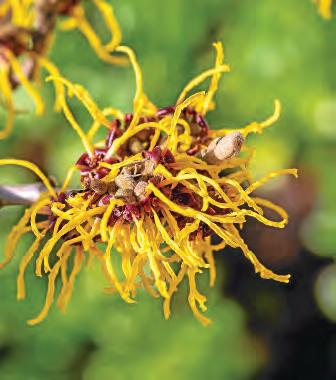
2 minute read
Landscape
from September 16, 2022
by Ladue News


Advertisement
Get Your Feet Wet
By Pat Raven, Ph.D., with Julie Hess
Many Ladue landscapes include newly developed rain gardens, natural boggy spots, intermittent rainwater sluices and pond or creek edges. These damp soils are perfect for showy small trees and interesting shrubs.
Most folks automatically associate damp soils with weeping willows and hydrangeas, but the world of water-lovers includes many more colorful native plants and horticultural selections. Some of our favorite choices of small trees and shrubs for wet-spot planting include these flowering and pollinator-friendly plants: Buckeyes – Aesculus, native red or white bottlebrush Buttonbush – Cephalanthus, native species, ‘Sugar Shack’ or ‘Fiber Optics’ Clove current – Ribes odoratus Dogwoods – Cornus, the native gray and silky dogwoods (not C. florida) Elderberry – Sambucus, native species or ‘Black Lace’ Fringe tree – Chionanthus, native species and Chinese introduction Joe-Pye-Weed – Eupatorium ‘Euphoria Ruby,’ ‘Gateway,’ ‘Little Joe’ and ‘Baby Joe’ Ninebark – Physocarpus ‘Diablo’ and ‘Petite Plum,’ ‘Darkstar’ or ‘Little Joker’ Pussywillow – Salix ‘Black Cat’ or dwarf arctic blue ‘nana’
Summersweet – Clethra ‘Little Hummingbird,’ pink ‘Ruby Spice’ or ‘Sixteen Candles’ Sweetspire – Itea virginica ‘Little Henry,’ ‘Henry’s Garnet’ for fall color or compact ‘Love Child’ Virginia magnolia – Magnolia ‘Green Shadow,’ ‘Moonglow’ and ‘Northern Belle’ Witch-alder – Fothergilla, native species or ‘Mount Airy’ Witch hazel – Hamamelis, native species or ‘Arnold’s Promise’
Get great red foliage color in the damp spring garden with dog-hobble (Leucothoe ‘Scarletta’), hazelnuts (Corylus, native, ‘Red Dragon’ and ‘Red Majestic’) or cool blue for the summer from Fothergilla ‘Blue Shadow.’ Autumn interest comes from golden-leaved spicebush (Lindera), the multihued witch hazels, witch-alders and cranberry Viburnum.
To spark seasonal interest and to attract more migratory birds to your rain garden, consider plants for fruit like arrowwood, Viburnum, the native species or ‘Chicago Luster,’ or chokeberry, Aronia ‘Low Scape Mound.’ The showstopping beautyberry, Callicarpa, is splendid in the native species, with brilliant lavender purple berries, the cultivar ‘Early Amethyst’ or Asian selection called ‘Profusion.’ Brighten the late season with winterberry holly, Ilex ‘Red Sprite’ or ‘Sparkleberry.’
Texture in the wet winter garden comes from form, like the corkscrewed branches of Harry Lauder’s walking stick (C. ‘Contorta’) or the ripped-muscle twists in the trunks of hornbeam (Carpinus), which is also a great larval host for butterflies. Stem colors from the yellow- and red-twig dogwoods add punctuation to the blah tones of the dormant landscape. The peeling bark of river birches can also be a focal point. The dwarf Betula ‘Fox Valley’ or ‘Little King’ is excellent for the edge of a pond or retention basin.
For serious creek bank erosion control, try our native rivercane, Arundinaria gigantea as a tenacious, thicket-forming bamboo. ‘Macon’ is a particularly hardy ecotype suitable for our climate. Like its Asian cousins, rivercane will spread, but the aggressive root system is what holds the soil together. It is also very popular habitat for warblers and other birds. Rarely tall enough to use for fishing poles, rivercane is a popular weaving material, so if your colony expands beyond its bounds, just make baskets. ln













